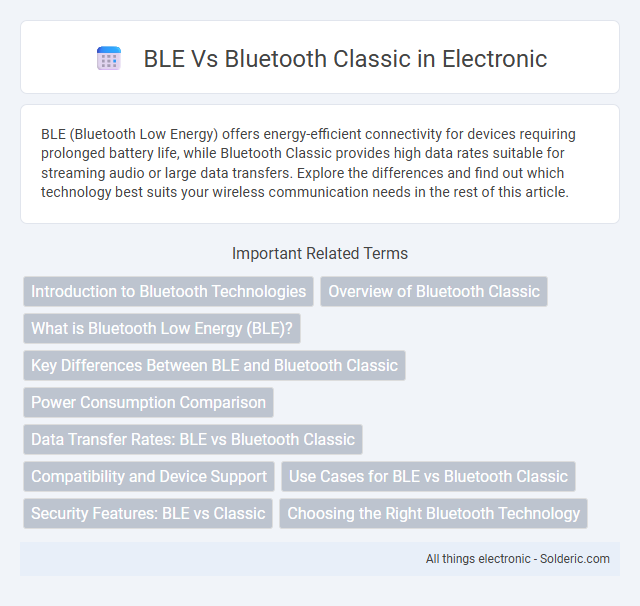BLE (Bluetooth Low Energy) offers energy-efficient connectivity for devices requiring prolonged battery life, while Bluetooth Classic provides high data rates suitable for streaming audio or large data transfers. Explore the differences and find out which technology best suits your wireless communication needs in the rest of this article.
Comparison Table
| Feature | Bluetooth Low Energy (BLE) | Bluetooth Classic |
|---|---|---|
| Primary Use | Low power, intermittent data transfer | Continuous, high data rate transfer |
| Power Consumption | Very low power | Higher power consumption |
| Data Transfer Speed | Up to 2 Mbps (Bluetooth 5) | Up to 3 Mbps (Bluetooth 2.0 + EDR) |
| Latency | Low latency optimized for quick connections | Moderate latency |
| Range | Up to 100 meters (Bluetooth 5) | Typically 10 meters |
| Connection Type | Connection-oriented and connectionless modes | Connection-oriented only |
| Application Examples | Fitness trackers, smartwatches, IoT devices | Audio streaming, file transfer, hands-free devices |
| Compatibility | Supported by Bluetooth 4.0 and later | Supported by all Bluetooth-enabled devices |
Introduction to Bluetooth Technologies
Bluetooth Low Energy (BLE) and Bluetooth Classic are wireless communication technologies designed for short-range data exchange but differ significantly in power consumption and application use cases. BLE is optimized for low energy usage, ideal for devices requiring long battery life such as fitness trackers and smart home sensors. Your device choice depends on whether you prioritize continuous data streaming with Bluetooth Classic or intermittent, power-efficient connections using BLE.
Overview of Bluetooth Classic
Bluetooth Classic, also known as Bluetooth BR/EDR (Basic Rate/Enhanced Data Rate), is designed for continuous, streaming data applications such as wireless audio and file transfers. It operates on the 2.4 GHz ISM band with data rates up to 3 Mbps, providing robust, reliable connections with low latency. Bluetooth Classic supports devices like headphones, speakers, and car infotainment systems, emphasizing sustained throughput and backward compatibility.
What is Bluetooth Low Energy (BLE)?
Bluetooth Low Energy (BLE) is a wireless communication technology designed to provide low power consumption while maintaining short-range connectivity, making it ideal for devices like fitness trackers, smartwatches, and IoT sensors. BLE operates on the 2.4 GHz ISM band and uses a different protocol stack than Bluetooth Classic, optimized for intermittent data transmission with minimal energy usage. Its primary advantage over Bluetooth Classic is extended battery life, achieved by reducing active radio time through efficient advertising and connection mechanisms.
Key Differences Between BLE and Bluetooth Classic
BLE (Bluetooth Low Energy) is designed for low power consumption and short bursts of data transmission, making it ideal for IoT devices and wearables. Bluetooth Classic supports continuous, high-throughput data streaming such as audio and file transfers, with higher energy consumption. Understanding these key differences helps you choose the right technology based on your device's power efficiency and data requirements.
Power Consumption Comparison
Bluetooth Low Energy (BLE) consumes significantly less power compared to Bluetooth Classic, making it ideal for battery-powered devices and applications requiring long operation times, such as fitness trackers and smart sensors. BLE achieves this efficiency by using short bursts of data transmission and longer sleep intervals, reducing current draw during idle periods. In contrast, Bluetooth Classic maintains continuous connections with higher power demands, suitable for applications involving sustained data streaming like audio or file transfers.
Data Transfer Rates: BLE vs Bluetooth Classic
Bluetooth Classic supports higher data transfer rates up to 3 Mbps with Enhanced Data Rate (EDR), ideal for streaming audio and large file transfers. BLE (Bluetooth Low Energy) offers significantly lower data rates, typically around 125 kbps to 2 Mbps, prioritizing energy efficiency and intermittent data transmissions. These differences make Bluetooth Classic suitable for continuous, high-throughput applications, while BLE excels in low-power, short-burst communication scenarios.
Compatibility and Device Support
BLE (Bluetooth Low Energy) offers broad compatibility across modern smartphones, tablets, and wearables, specifically optimized for low-power devices and IoT applications. Bluetooth Classic supports a wider range of legacy devices, including older audio peripherals and automotive systems, but consumes more energy. Your choice depends on device support requirements and power efficiency priorities in your application.
Use Cases for BLE vs Bluetooth Classic
BLE is ideal for low-power, intermittent data transmission applications such as fitness trackers, smartwatches, and IoT sensors, where conserving battery life is crucial. Bluetooth Classic supports high-throughput use cases like wireless audio streaming, file transfers, and continuous data exchange, making it suitable for headphones, car audio systems, and wireless speakers. Your choice between BLE and Bluetooth Classic depends on whether your priority is energy efficiency or data transfer speed for reliable device connectivity.
Security Features: BLE vs Classic
Bluetooth Low Energy (BLE) implements enhanced security features such as AES-128 encryption, secure pairing with Just Works, Passkey Entry, and Numeric Comparison methods, along with improved privacy through rotating device addresses to prevent tracking. Bluetooth Classic relies on legacy pairing methods with link key generation, PIN codes, and encryption standards that are less robust compared to BLE's modernized security protocols. BLE's security architecture is specifically designed to support low-power devices while maintaining strong protection against eavesdropping and man-in-the-middle attacks, making it preferable for IoT applications requiring secure data transmission.
Choosing the Right Bluetooth Technology
When choosing the right Bluetooth technology, consider Bluetooth Low Energy (BLE) for applications requiring minimal power consumption and intermittent data transfer, such as fitness trackers and smart home devices. Bluetooth Classic suits scenarios demanding continuous audio streaming and higher data throughput, like wireless headphones and car audio systems. Evaluating device compatibility, battery life priorities, and use case requirements ensures optimal Bluetooth technology selection.
BLE vs Bluetooth Classic Infographic

 solderic.com
solderic.com